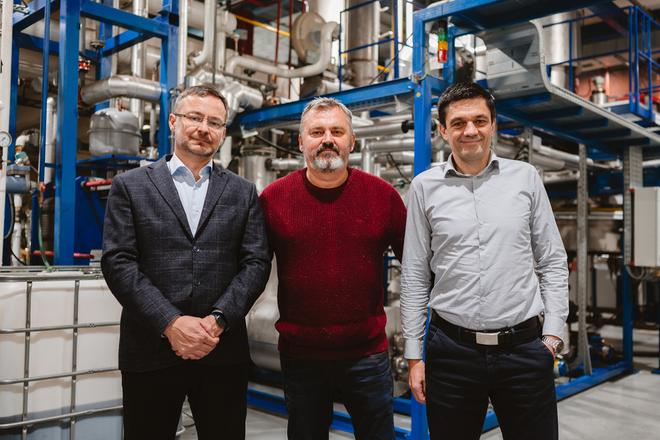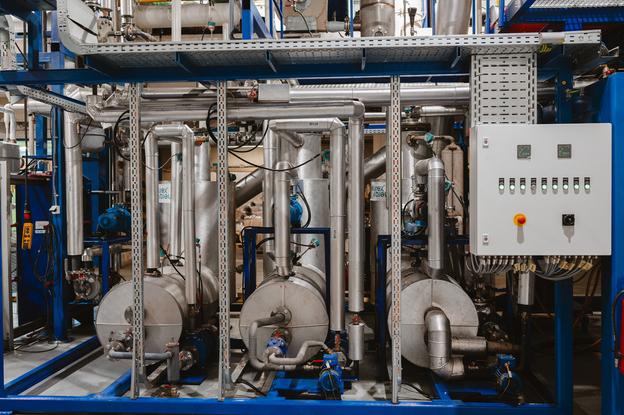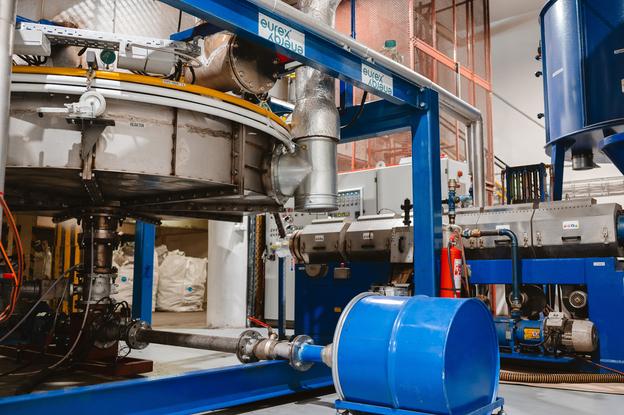Plastic waste is one of the biggest problems for the environment today. According to Eurostat, 60 million tons of plastic is produced every year in Europe alone, but only around 40 percent is recycled. According to the OECD, it is less than 10 percent globally.
Waste sorting and the recently launched PET bottle deposit return scheme help. But the issue with traditional mechanical recycling is gradual material degradation. Plastic flakes can thus be used for further manufacture only two to three times.
The solution to this problem is offered by a new compact line for recycling and recovery of plastics by chemical-thermal processes, which was built by the Slovak company Eurex Energy of entrepreneur Vladimír Daniška after several years of intensive research and development in the field of waste processing. Chemical processes lead to the decomposition of plastics into hydrocarbon fractions - usable as chemical substances - raw materials.
The resulting product from the Slovak Eurex Energy line can be certified as secondary fuels suitable as a substitute for fuels from fossil sources, for example in cogeneration units. In one process, with the use of reagents and processes in the gas phase, such purity of liquid outputs are achieved that they can be directly used for chemical production as raw material for input. Part of the non-condensable gases is also used for process heating, which significantly reduces energy consumption from external sources.
Siemens specialists and technologies helped
Chemical and mechanical engineers together with Siemens industrial automation experts have spent many months researching, developing and modifying the technology for the chemical recycling of waste plastics through thermal processes to make it as environmentally friendly, automated and efficient as possible.
The result of their efforts is a compact line built on a unique three-phase process. In the first, the mechanical-thermal phase, the incoming waste is appropriately treated and freed from most of the water and other pollutants. All polyethylene (PE) and polypropylene (PP) plastics can be recycled in any proportion, even with slight contamination up to 5 percent of their total weight. Plastics can come from municipal or industrial waste, but also directly from landfills and other sources. A molten mass is formed, which in the second phase is decomposed in the reactor into processed gas at a temperature of up to 430 ºC.
The system developed by Eurex Energy has several advantages over similar solutions. The first is extremely compact dimensions. The entire technology fits into an area of only 150 m2 and is only 6 metres high, thanks to which it can be installed for a significantly higher number of customers than competing lines. In addition to removing heavy hydrocarbons and solid substances such as stone, sand, glass or clay, the line can also eliminate pollutants from the gas phase by wet scrubbing and dry filtration.
"In our case, the input that comes to the reactor is not the treated mixed plastic waste, but the melt. It is essentially a thermally prepared intermediate product free of moisture, air and most problematic pollutants. We remove them from the recycling process, and thanks to this they do not pollute the final products," explained Vladimír Daniška, head of Eurex Energy, adding, "another big advantage is energy efficiency. Heat processing of plastics is energy intensive. In our solution, the initial heating of the polymer to more than 200 ºC occurs in the extruder and not in the reactor, which is more energy efficient, because we supply energy mainly by friction and not by external heat. The use of gas infrared heaters reduces gas consumption and minimises air pollution by emissions."
The Eurex Energy line can also work continuously, so it has no temperature fluctuations. This increases the quality of the output recycled material, which is not subject to thermal shocks as is the case with batch technologies. In their case, the prerequisite for obtaining outputs is in virgin quality, even without further processing, said Daniška.
Key partners of this unique project
Eurex Energy's partners, Chemosvit Group and Siemens, played a key role in the research and development of technology for continuous chemical recycling of plastics by thermal processes.
The Chemosvit Group is ideal for deploying the Eurex Energy pilot line, as it produces a large volume of waste and consumes a lot of energy. The group also includes the company Chemosvit Strojchem, which is dedicated to engineering production and will be responsible for the production of lines for chemical recycling of plastics for other customers from all over the world.
The second key partner is Siemens, which supplies the line with control systems ensuring its autonomy. "When introducing automation and digitization for this type of technology, it is important to use modern control systems that contain libraries and blocks necessary for controlling continuous chemical processes, have a long service life and guaranteed long-term support. All these criteria are met by the Siemens Simatic PCS 7 system, which is the control centre of the line," said Marián Filka from the Digital Industries department at Siemens.
Simatic PCS 7 has extensive possibilities for storing and trending process data. The obtained data can be used to optimise operations, including energy consumption. The Eurex Energy recycling line also uses other Siemens products and technologies – Sitrans sensors for measuring flow, temperature or pressure and Siwarex strain gauges for weighing mixtures during production. Sinamics frequency converters and drives and Scalance or Sinema components for remote line management and diagnostics are also included.
The Slovak Siemens team also provided extensive support and training for Eurex Energy prior to the project work on the Simatic PCS control system and the Sitrans process device, as well as in the next phases of the project – during start-up, programming and revitalisation of the control system.
“When I met with the experts from Siemens, I said that we need to achieve automatization to the greatest extent possible. We explained for a few months how the different processes are supposed to look like, and what needs to be preserved for a high-quality final product. Now we need only two people instead of ten for managing the line, and our vision is to achieve complete autonomy,” stated Daniška. Automatization not only saves expenses for the international customers using the Eurex Energy line, but also sustains high quality output consistently.
Pilot line helps in real life
The fully functioning Eurex Energy line on the Chemosvit premises will serve both as a presentation of the solution to potential customers from Slovakia and the world, and it will help a chemical giant to use its waste materials. Thanks to the line, Chemosvit can lower expenses for energy significantly, as the line produces fuel used for the production of electricity. The estimated line investment return is approximately 10 years.
New opportunities are offered to the daughter company Chemosvit Strojchem as well. "We can produce dozens of lines annually for continuous plastic recycling for Eurex Energy customers from around the world," said Martin Ľach, member of the Chemosvit Group board. This affects not only international industrial businesses, but also smaller and larger Slovak cities and municipalities, as they make use of plastic waste from the yellow bins. "Long distance transport of waste (250 or more kilometres) for processing is not only non-ecological, but also non-profitable. Thanks to our line, municipalities and cities can lower their carbon footprint and produce their own energy, which can be used for public lighting or other purposes," added Daniška.
Based on the regulation of the European Union, part of the waste will have to be converted into energy as early as 2027. However, countries lack the capacity and technology to process plastics. Half of the waste intended for recycling is therefore exported to third countries today. In the past, most of it went to China, but it has already banned the import of plastic waste. "Chemical recycling in the EU will help prevent plastics from having to be burned or ending up in landfills," Daniška concluded.
This article has been brought to you by Siemens.


 from left: Martin Ľach, Vladimír Daniška, Marián Filka
from left: Martin Ľach, Vladimír Daniška, Marián Filka

